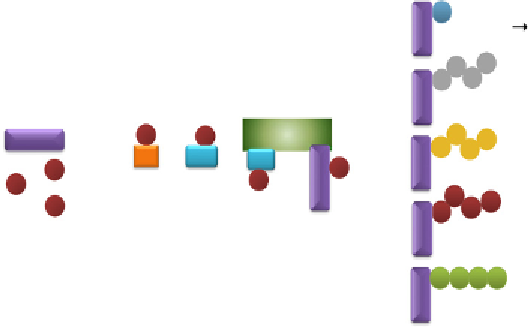Biology Reference
In-Depth Information
of ubiquitin by the formation of ubiquitin adenylate intermediate. This is
followed by the transfer of activated ubiquitin to the E1 active site cysteine
to form a thioester linkage with concomitant release of AMP. Activated
ubiquitin is then transferred to a thiol site of an E2 ubiquitin-conjugating
enzyme via a transacylation reaction (
Fig. 7.2
). The last step in the
ubiquitination cascade creates an isopeptide bond between a lysine residue
Trafficking
Endocytosis
Localization
Gene expression
Gene silencing
Ub
Mono-Ub
Ub
Ub
Ub
Ub
Protein degradation?
DNA repair?
K6, K29
AMP + PPi
ATP
E3-Ub ligase
Ub
Ub
Ub
Ub
Protein
Ub
Ub
E2
E1
??
E2
1
Ub
Ub
2
K27, K33
Ub
Ub
3
Ub
Ub
Ub
Ub
Ub
26S Proteasomal
degradation
K11, K48
NF-
κ
B activation
Ub Ub Ub Ub
Signaling
Localization
DNA repair
Trafficking
Translation
Kinase activation
K63
Figure 7.2 Schematic representation of ubiquitination. Ubiquitin (Ub), a highly con-
served 76 amino acid polypeptide, is covalently attached to substrates by an isopeptide
bond between a substrate lysine residue and the C-terminal glycine residue of ubiquitin.
Ubiquitination is carried out by three distinct enzymes: an ubiquitin-activating enzyme
(E1), an ubiquitin-conjugating enzyme (E2), and an ubiquitin-ligating enzyme (E3).
As the first step, the C-terminal glycine residue of ubiquitin, G76, is activated by
the E1 enzyme in an ATP-dependent reaction, resulting in an intermediary ubiquitin
adenylate, release of pyrophosphate (PPi), and the attachment of ubiquitin to a cysteine
residue in E1. The activated ubiquitin is subsequently transferred to an active cysteine in
E2 (ubiquitin-conjugating enzyme). Next, a ubiquitin protein ligase E3 recruits the car-
boxyl terminus of charged ubiquitin on the E2 to an e-amino group of a lysine residue in
the substrate protein. Attachment of a single ubiquitin at a single site in the substrate is
called monoubiquitination, whereas one ubiquitin attached at multiple sites is referred
as multi-monoubiquitination. When successive additions of four or more ubiquitins are
made to a lysine within the previously added ubiquitin, a polyubiquitin chain is formed.
Substrates that are monoubiquitinated, multi-monoubiquitinated, or polyubiquitinated
(excluding K48 poly ubiquitination chains) are not degraded, and such ubiquitination
facilitates change in the activation state of the substrate, localization, or signaling.
The consequences of different types of polyubiquitin chain linkages formed on sub-
strates are listed. Conversely, substrates that are polyubiquitinated by K48-linked chains,
with at least four or more ubiquitin molecules on the same lysine residue in the sub-
strate, are generally rapidly degraded by 26S proteasome.












Search WWH ::

Custom Search